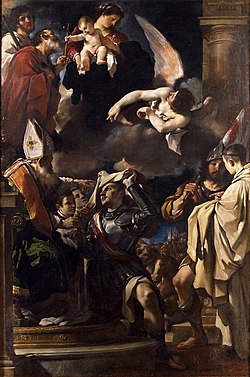Saint William of Gellone | |
|---|---|
 William of Gellone, Guillaume d'Orange, William of Aquitaine by Guercino | |
| Born | c. 755 somewhere in northern France |
| Died | 28 May 812 or 28 May 814 Gellone, near Lodève? |
| Spouse(s) | Cunegonde and Witburgis |
| Children | Bernard, Witcher, Gotzelm, Heribert, Helimburgis, Gerberge and (perhaps) Rotlinde |
| Venerated in | Roman Catholic Church Eastern Orthodox Church |
| Canonized | 1066 by Pope Alexander II |
| Major shrine | Monastery of Saint-Guilhem-le-Désert in Gellone, France |
| Feast | May 28 |

William of Gellone (c. 755 – 28 May 812 or 814), the medieval William of Orange,[1] was the second Duke of Toulouse from 790 until 811. In 804, he founded the abbey of Gellone. He was canonized a saint in 1066 by Pope Alexander II.[2]
In the tenth or eleventh century,[3] a Latin hagiography, the Vita sancti Willelmi, was composed. By the twelfth century, William's legend had grown. He is the hero of an entire cycle of chansons de geste, the earliest of which is the Chanson de Guillaume of about 1140. In the chansons, he is nicknamed Fièrebrace (fierce or strong arm)[4] on account of his strength and the marquis au court nez (margrave with the short nose) on account of an injury suffered in battle with a giant.
- ^ Occitan: Guilhem d'Aurenga, French: Guillaume d'Orange
- ^ "William of Aquitaine, St.". Encyclopedia.com. Retrieved on 2014-01-17.
- ^ Written before the 11th century, according to Jean Mabillon, or during the 11th century according to the Bollandist Godfrey Henschen.
- ^ Cf. Firapel in the Roman de Renart: strong skin, like iron-hide